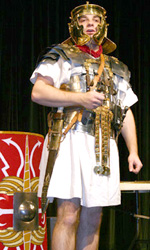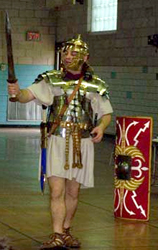Andy Volpe: Art & History
Living History Presentation: Roman Legionary
|
|
This program/presentation focuses on the Roman soldier during the first Century, roughly 60-120 AD/CE at the height of Roman Legion prowess. I explain the origins of the Legionary, his arms, armor, and equipment. I discuss everyday life of a Legionary, what was expected of him, as well as discussing the Fighting Tactics and strategy of the Romans, and try to utilize audience participation as best I can. My presentation has evolved and changed over the years, reflecting the newest archaeological discoveries, academic research, and re-examining or re-evaluating what we know and how we know it; my theories and interpretations try reflect this. I try to utilize Three Elements in my program: 1. The Artifacts themselves, what has been excavated. 2. Something Written about those artifacts or objects, surviving written evidence. 3. Artwork, what survives in Roman artwork in sculpture, fresco, mosaic, etc. All of my replicas are copies of actual artifacts that are seen in museums and collections (and I'm slowly acquiring some actual artifacts of my own collection!), or otherwise a combination of at least 2 of these Elements. I try to have a variety of objects that pertain to the Roman military and Roman culture. One of my growing interests is in the writings left behind by the Romans, particularly from Roman-Egypt. I have a couple of wax tablets, papyrus, wood slips and ostraka that can be handled by the audience.
My program generally aims to give just a glimpse into the soldier himself, who he was, what he was up against. The soldier’s life was and is never easy, and they are always connected to civilization and society. I try to get people "up close" to the arms and armor so they can see how it works, how it fits on the body, how the weapons were designed and used, etc. I try to incorporate as much "audience participation" as possible for an interactive experience. Unfortunately there is a lot of misinformation about the Roman army out there, be it from TV, Movies, Games, or even old textbooks and history books. Sometimes an interpretation or theory ends up becoming a "fact" with no solid basis or shoddy evidence. I'm regularly researching and keeping on top of the newest archaeological and academic information available in Roman military studies, and my program and presentation has changed several times in the 10+ years I've been at it. A much more detailed description of my presentation and the topics I try to touch on (ie STEM/STEAM, Archaeology, Science, etc) can be found Here. PROGRAM OPTIONS: Lecture: 45 minutes to 1 hour. I present on the topics mentioned above. Interactive Lecture: 35 ~ minutes. I give a brief synopsis with more time (ca 15-20 minutes) for Q & A for the audience/students. Hands-On / Try-On: (time depends on space available). A few tables with replica helmets, wax tablets, personal items, dice, and some of (my) research books can be made available for students to examine and try on, take selfies, etc. All of my Roman programs have me in my soldier's "kit" (see photos), I can dress either in the more popular Imperial (wearing the so-called Lorica Segmentata), or, come dressed in an earlier period seen in the Punic Wars until Caesar (wearing maille) Program costs are not affected by these options, and, I am open to varying these formats if you're looking for something specific. I try to be pretty flexible. Program History: I have presented notably at Higgins Armory Museum in Worcester, which closed in 2013, although the collection is now part of the Worcester Art Museum. I continue to present at WAM on a somewhat regular basis similarly as I did at Higgins. Since 2004 I have visited several schools and colleges in the New England region; have presented or provided "presence" at Massachusetts, Connecticut, New Hampshire and Virginia Junior Classical Leagues; The International Archaeology Day annual event at the Museum of Science Boston; colleges and universities have included Fitchburg State, Brandeis, Syracuse, Brown/Joukowsky Institute, Assumption, College of the Holy Cross, Franklin Pierce, UMass Boston, UMass Amherst and also at Penn Museum and Franklin Institute in Philadelphia. I also try to attend the Annual Meeting of the Classical Association of New England. For an extensive list of schools and other venues, please see here.
|
|---|

